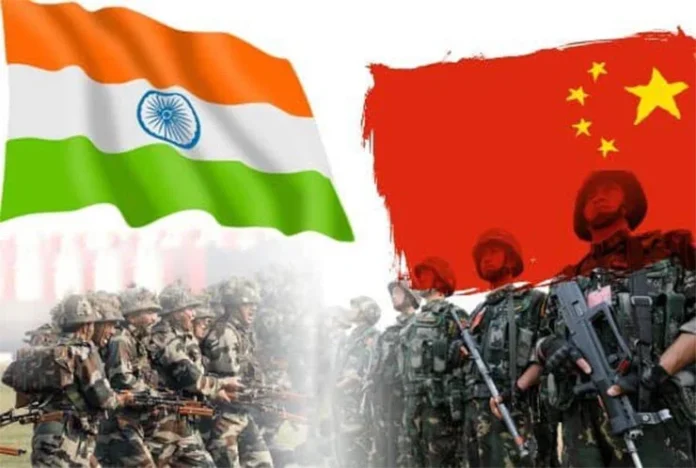There is no denying the significant asymmetry between India and China in terms of their military capabilities and resources. China, with its larger economy and substantial defence budget, appears to have a clear edge over India in various military dimensions. However, New Delhi does not necessarily need to match Beijing in both quantity and quality to effectively counter this gap. Instead, a strategic approach that bolsters specific areas of India’s defence capabilities can address this challenge efficiently and effectively.
The strategic rivalry between India and China is heavily influenced by the asymmetry in their military capabilities and resources. This disparity is a crucial factor shaping their interactions and strategic calculations. According to the Delhi Policy Group, China’s defence budget is approximately four times that of India. This substantial financial advantage allows China to invest heavily in advanced military technologies and infrastructure, which translates into a more extensive and sophisticated arsenal. This arsenal includes a larger number of ballistic missiles, nuclear submarines, and advanced fighter jets.
Imbalance in Military Infrastructure and Logistics
China’s strategic investments in infrastructure, particularly in the Tibet Autonomous Region, significantly enhance its military logistics and rapid deployment capabilities along the border. The construction of highways, railways, and airfields near the Line of Actual Control (LAC) ensures that Chinese forces can be quickly mobilised and sustained in conflict scenarios. This logistical superiority presents a stark contrast to India’s relatively slower and less developed infrastructure in the border regions, limiting its operational readiness and response time.
Technological Advancements and Multidimensional Warfare
China’s technological advancements further underscore this asymmetry. The People’s Liberation Army (PLA) has made significant strides in areas such as cyber warfare, space capabilities, and artificial intelligence (AI). These advancements provide China with a multidimensional approach to modern warfare, integrating both conventional and non-conventional domains to enhance its strategic deterrence. In contrast, India’s progress in these areas, while noteworthy, lags behind China’s rapid developments, further widening the capabilities gap.
Naval Power Disparities
The asymmetry extends to naval power as well, with the Chinese People’s Liberation Army Navy (PLAN) expanding its blue-water capabilities, including aircraft carriers and advanced warships, to project power far beyond its immediate region. India’s navy, although robust and competent, is primarily focused on regional security and lacks the same global reach and logistical support as the PLAN. This disparity affects the balance of power in the Indian Ocean Region (IOR), a critical area for India’s strategic interests.
Infrastructure development in the border regions to enhance logistics and operational readiness is another crucial area. India’s construction of highways, railways, and airfields in the challenging terrains of the Himalayas is progressing steadily. However, these efforts involve complex engineering and significant financial outlays, making it a gradual process
The Challenge of Bridging the Gap
Bridging the military capabilities gap with China will be a challenging and time-consuming endeavour for India, primarily due to the vast scale and complexities of the undertaking. India’s growing economy and strategic initiatives have laid a solid foundation for military enhancement, but matching China’s extensive advancements requires significant, sustained effort.
Economic Considerations
First, while India’s economy is robust and expanding, aligning defence spending with China’s substantial budget necessitates strategic allocation of resources. Prioritising military modernisation without compromising other critical national investments requires careful planning and balanced fiscal management.
Technological Advancements
The development and acquisition of advanced military technologies, such as cyber warfare capabilities, AI, and aerospace advancements, require significant investments in research and development. India’s defence industry is advancing rapidly, but building a technological edge comparable to China’s well-established infrastructure will take time and focused effort.
Strategic Approach for India
To effectively counter the asymmetry with China, India can adopt several strategic measures:
- Enhancing Strategic Partnerships: Forming and strengthening alliances with key global and regional powers, such as the United States, Japan, and Australia, can provide India with advanced technologies, intelligence sharing, and military training that bolster its defence capabilities.
- Focused Military Investments: Rather than attempting to match China in every aspect, India can focus on critical areas where it can achieve substantial gains. This includes investing in missile technology, air defence systems, and enhancing cyber warfare capabilities to counter specific Chinese threats.
- Infrastructure Development: Accelerating infrastructure development in border regions is essential to improve logistics and operational readiness. This includes building more highways, railways, and airfields to ensure rapid mobilisation and sustainment of Indian forces along the LAC. India’s construction of highways, railways, and airfields in the challenging terrains of the Himalayas is progressing steadily. However, these efforts involve complex engineering and significant financial outlays, making it a gradual process. The harsh weather conditions and rugged terrain add to the difficulty, but the strategic importance of these developments cannot be overstated.
- Technological Innovation: Investing heavily in research and development to advance indigenous military technologies will not only reduce dependency on foreign suppliers but also ensure that India develops cutting-edge capabilities tailored to its strategic needs.
- Naval Modernisation: Expanding and modernising the Indian Navy to enhance its blue-water capabilities and ensure a strong presence in the IOR can help counter China’s growing influence and maintain a strategic balance in the region.
Military Training and Upgrade
Training and equipping a technologically advanced military force is a gradual but essential process. It involves acquiring new equipment, developing doctrines, and ensuring interoperability across various branches of the armed forces. This transformation, although demanding, is vital for enhancing India’s defence capabilities. Effective military training programs must be implemented to prepare personnel for the use of advanced technologies and modern warfare tactics. This includes joint exercises with allied nations, which provide valuable experience and improve coordination among different military branches.
Innovative Military Strategies
Instead of focusing solely on bridging the overall military capabilities gap with China, India should strategically bolster specific aspects of its defence industry to compensate for this gap more effectively. This approach can provide targeted advantages and enhance India’s defensive and offensive capabilities in ways that directly address its unique strategic needs and constraints. For example, prioritising the development of asymmetric warfare capabilities, such as cyber warfare and special operations, can provide India with significant leverage in conflicts where conventional military superiority is not as decisive.
Training and equipping a technologically advanced military force is a gradual but essential process. It involves acquiring new equipment, developing doctrines, and ensuring interoperability across various branches of the armed forces. This transformation, although demanding, is vital for enhancing India’s defence capabilities
Enhancing Cyber Security
Enhancing cyber security should be India’s top priority. Cyber threats are pervasive and can significantly undermine national security. By investing in robust cyber security measures, India can protect its critical infrastructure, secure communication networks, and safeguard sensitive data from cyber espionage and attacks. Initiatives like the partnership between SIA-India (Society for Innovation and Development in Aerospace) and the Information Sharing and Analysis Centre (ISAC) aim at bolstering India’s cyber resilience, reflecting a proactive stance in this domain. Strengthening cyber security capabilities also includes the development of offensive cyber capabilities to deter and respond to cyber threats effectively, ensuring a comprehensive approach to national cyber defence.
Weapons Production Quality
India’s defence strategy should focus on the quality of weapons rather than sheer quantity. By prioritising the development and procurement of high-quality, technologically advanced weapons systems, India can ensure that its military remains capable of countering sophisticated threats. This includes modernising existing platforms and acquiring advanced drones, precision-guided munitions, and state-of-the-art air defence systems. The emphasis on indigenous production through initiatives like ‘Make in India’ will not only reduce dependence on foreign suppliers but also foster innovation and self-reliance in defence technologies. Developing a strong domestic defence industry is crucial for sustaining long-term military capabilities and ensuring that India can rapidly adapt to new technological advancements.
Enhancing cyber security should be India’s top priority. Cyber threats are pervasive and can significantly undermine national security. By investing in robust cyber security measures, India can protect its critical infrastructure, secure communication networks, and safeguard sensitive data from cyber espionage and attacks
Bolstering Special Operations
India should enhance its special operations and guerrilla warfare capabilities. Special operations forces (SOF) are crucial for conducting unconventional warfare, including counter-terrorism, reconnaissance, and direct action missions. These units can operate in hostile environments, execute precision strikes, and conduct covert operations that conventional forces might find challenging. Strengthening guerrilla warfare units, particularly in regions with difficult terrain such as the Himalayas, would provide a significant strategic advantage. These units can leverage their mobility, local support, and intimate knowledge of the terrain to effectively counter larger, more conventional forces.
Integrated Defence Strategy
A holistic approach that integrates these specialised capabilities can create a synergistic effect. For instance, advanced cyber security measures can support special operations by providing real-time intelligence and secure communications. High-quality, indigenously produced weapons systems can be tailored to meet the specific needs of the Special Forces, increasing operational effectiveness. Furthermore, integrating irregular warfare tactics into the broader defence strategy can disrupt adversary operations, create strategic ambiguities, and impose high costs on any potential aggressor.
India’s defence strategy should focus on the quality of weapons rather than sheer quantity. By prioritising the development and procurement of high-quality, technologically advanced weapons systems, India can ensure that its military remains capable of countering sophisticated threats. This includes modernising existing platforms and acquiring advanced drones, precision-guided munitions, and state-of-the-art air defence systems
Joint Military Exercises
Engaging in technology-sharing agreements with advanced military powers can accelerate India’s acquisition of cutting-edge technologies. Joint military exercises not only enhance interoperability with partner nations but also provide valuable training and experience for the Indian forces in diverse operational environments. These exercises help Indian military personnel adapt to different combat scenarios and improve coordination with allied forces, enhancing overall combat readiness.
Intelligence Sharing
Strengthening intelligence-sharing mechanisms with trusted allies can improve India’s situational awareness and early warning capabilities. Such activities, particularly in the Indo-Pacific region, can help balance China’s influence and provide a collective security framework to address common threats. Enhanced intelligence sharing can lead to better-informed strategic decisions and more effective countermeasures against potential adversaries.
Strengthening Strategic Ties
India should continue to build and strengthen strategic partnerships with other nations to enhance its defence capabilities. Collaborative efforts in technology sharing and joint military exercises can provide India with additional resources and support. These partnerships can also serve as a force multiplier, extending India’s strategic reach and influence. By fostering strong alliances, India can create a network of support that enhances its security and counters China’s clout.
The author is a Defence, Aerospace & Political Analyst based in Bengaluru. He is also the Director of ADD Engineering Components India Pvt Ltd, a subsidiary of ADD Engineering GmbH, Germany. You can reach him at: girishlinganna@gmail.com
-The author is a Defence, Aerospace & Political Analyst based in Bengaluru. He is also Director of ADD Engineering Components, India, Pvt. Ltd, a subsidiary of ADD Engineering GmbH, Germany. You can reach him at: girishlinganna@gmail.com. The views expressed are personal and do not necessarily carry the views of Raksha Anirveda






